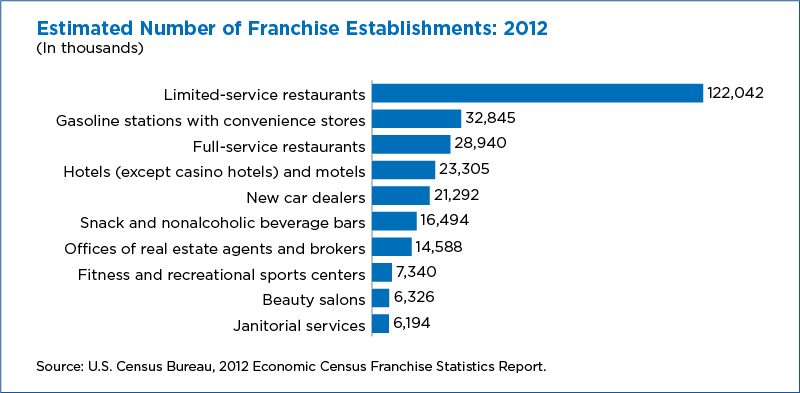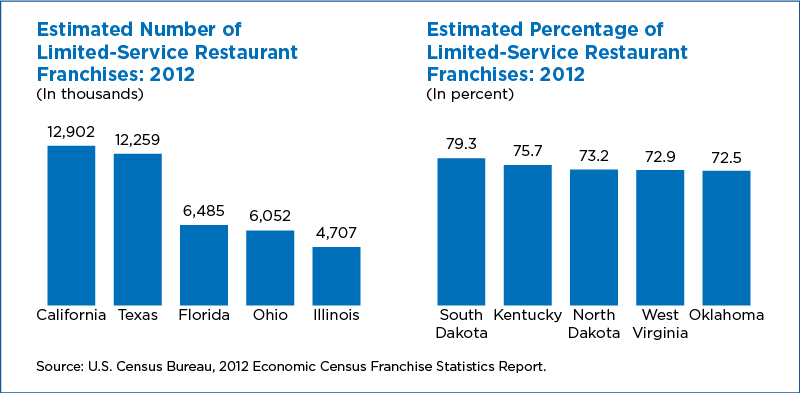Economic Census Shows Franchising Key to Many Industries
Mention franchises, and images of the thousands of fast-food restaurants that dot landscapes across urban and rural America immediately come to mind.
Franchises, however, go well beyond fast-food chains. They are important to many industries instrumental in providing other day-to-day services, from storage and warehousing to eyeglass stores and weight-loss centers.
Detailed data on franchises comes from the Economic Census, which is taken every five years, and covers employer businesses in the United States. The latest Economic Census will be conducted this year, and continue to offer detailed information only available through this program. Comprehensively collected for the first time for the 2007 Economic Census, the franchise question covers over 300 different types of businesses (industries) and measures the number of franchisee- and franchisor-owned businesses in each industry and their total employment, annual payroll and sales.
The question was added as part of a partnership that was established between the International Franchise Association (IFA) and the U.S. Census Bureau. This partnership has not only resulted in data that entrepreneurs can use but may also have helped improve the overall response rates that impact the general data quality for these industries. Businesses in these industries often rely on organizations like IFA for guidance and their role as a “trusted voice” of their industry can help promote response to our surveys.
The franchise data from the 2012 Economic Census revealed some information that few would find surprising. For example, the estimated 122,042 limited-service franchise restaurants (NAICS 722513) make up approximately 54 percent of all fast-food restaurants in the United States, nearly 70 percent of the sales of fast-food restaurants ($185.4 billion), and about 73 percent of the employment of fast-food restaurants (3.6 million).

However, the data did reveal the importance of franchise businesses in industries that many might not immediately associate with franchising. For example:
- About 63 percent of the 3,149 private mail centers (NAICS 561431) and 53 percent of the 3,186 diet and weight reducing centers (NAICS 812191) in the United States are franchises.
- While only 3 percent of the 23,931 used car dealers in the United States (NAICS 441120) are franchises, these franchise dealers make up approximately 24 percent of the sales of this industry ($67.2 billion) and 17 percent of the total employment in the industry (124,394).
- Only 77 of the 10,243 general warehousing and storage (NAICS 493110) businesses are franchises, but these businesses reported annual payroll per employee of $114,598, which is $75,954 more than the average for all businesses in this industry.
- While franchise businesses can be operated by either the franchisor (the company that owns the franchise) or the franchisee, about 93 percent of the 5,982 optical goods franchise stores (NAICS 446130) are operated by the franchisor. The opposite is true for car dealers: 100 percent of the 21,292 new car dealers in the United States (NAICS 441110) are operated by a franchisee.
The 2012 Economic Census Franchise report also provided data at the state level for full- and limited-service restaurants. For example, while California had the most limited-service franchise restaurants (12,902), franchises made up only 47 percent of all limited-service restaurants in the state. In South Dakota, the 410 limited-service restaurant franchises made up 79 percent of all of the limited-service restaurants in the state. Vermont reported not only the least number of limited-service franchise restaurants (77) but also the lowest percentage (20 percent).

As the Census Bureau begins the collection phase for the 2017 Economic Census, it will continue to reach out to national and local business organizations to promote the value of the data that comes from all programs and to ask for their assistance in promoting response to the Economic Census and to all its economic surveys. Information from the Economic Census often derives from partnerships that the Census Bureau has fostered with business associations and organization that rely on these data. To learn more about the economic census, visit <www.census.gov/EconomicCensus>. This site not only includes general information about the value of the data (including real-life use cases) but also promotional materials that organizations can use on their websites and elsewhere.
Andrew W. Hait is a Survey Statistician/Economist at the Census Bureau.
Note: Differences between estimates may be attributed to sampling or nonsampling error, rather than to differences in underlying economic conditions. Caution should be use in drawing conclusions from the estimates and comparisons shown.






